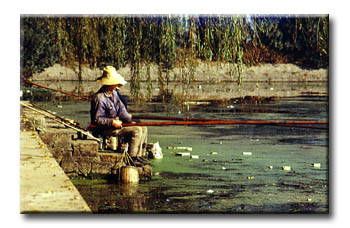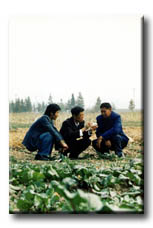Spiders Help Farmers
Grow Safer Crops
(Any time you see a link, you can click it for more
information on that word or topic)
What's the Problem?
Worldwide, about a million people are poisoned by pesticides
each year; ten thousand of these victims die from such poisonings. The
risks are greatest in developing countries. Ninety-nine percent of the
deaths caused by agricultural chemicals occur in those countries.
Many farm workers cannot read the warning labels about careful use,
because they do not know how to read or because the label is in a foreign
language. The farmers may be totally unaware of the dangers of handling
these chemicals. Often they don't know that they should avoid reusing
pesticide containers for food or water. And when they do understand the
warnings, they often don't have protective clothing or proper storage
facilities.
Chemical pesticides have helped millions of people, yet are a mixed
blessing. In addition to the human risks associated with pesticide use,
the pests they are supposed to control can provide problems of their own.
A good example can be found in the efforts to control mosquito populations.
In 1958, the World Health Organization intensified the efforts to eradicate
malaria, which
is carried and spread by mosquitoes. The insecticide DDT was found to
kill the malaria-causing mosquitoes and the number of people contracting
malaria fell dramatically after spraying of infested areas with DDT.
Then suddenly, after only five years of spraying, the momentum reversed.
Every two years the number of people suffering from malaria doubled. The
mosquitoes had developed a resistance
to DDT.
The startling realization of how quickly and effectively mosquitoes
develop resistance to chemical control was to be seen again and again
in the attempts to control insects - both those carrying disease and those
plaguing farmers' crops. The malaria story - an intensive pesticide campaign
followed by new generations of pests who outlive any attempt to kill them
- by now is a familiar one. It's happened in efforts to wipe out insects
that carry diseases, and it's happened when farmers have tried to rid
their fields of pests.
Nearly 25% of the world's pesticides are used on cotton - in the United
States nearly 50%. But despite this massive bombardment with chemicals,
yields are declining in much of the world. In the United States, cotton
growers in Texas and other states gave up vast acreage of cotton when
pesticides became to expensive and not effective enough. With chemical
dependence, shrinking yields, and decreasing income from crops, the agricultural
picture is too often a grim one.
What's the Story?
 Many
centuries ago, farmers in China first tried the sensible idea of using
natural predators to control crop pests. Many
centuries ago, farmers in China first tried the sensible idea of using
natural predators to control crop pests.
Today, Dr. Zhao Jingzhao, President of the University of Hubei, renews
the promise of this ancient technique. He has made tremendous advances
with biological control which are setting examples for other countries.
The farmers Zhao works with combine this technique with a very modest
use of chemical pesticides. That combination is known as integrated pest
management.
China is the world's biggest producer of cotton. Cotton has posed difficulties
to its growers for hundreds of years - in China, in the United States,
and in other countries.
People who work in the cotton fields of China's Hubei Province, where
cotton is the chief crop, once relied solely on pesticides. But even as
they spent more and more money on them, they saw their harvests dwindle,
and that chemicals could make you ill.
Zhao set about to help those farmers. To do so, he has dedicated more
than ten years of his life to studying various means of biological pest
control.
Nearly two thousand years ago, in the orange groves of China, farmers
came up with a new way to do battle with insect pests. Beetles, mites,
and stinkbugs plagued their trees. Farmers would release ants among the
trees, and the ants would dine on the uninvited guests. The farmers knew
which species of ants to use - how to breed the ants - and the ideal time
of year to put them to work.
 Today,
near Wuhan on the Yangtse River, 1,000 kilometers south of Beijing, Dr.
Zhao Jingzhao is continuing this tradition by finding ways to control
cotton pests with their natural enemies. Today,
near Wuhan on the Yangtse River, 1,000 kilometers south of Beijing, Dr.
Zhao Jingzhao is continuing this tradition by finding ways to control
cotton pests with their natural enemies.
In China, the main cotton pest is the boll
weevil - also a danger to cotton crops in other countries. Zhao's
efforts to perfect new methods of biological control have a certain urgency,
because farmers and scientists are increasingly troubled by the costs
and dangers of chemical pesticide use.
Fifteen years ago Zhao turned his attention from rice cultivation to
cotton in an effort to reduce the use of chemicals and to stop the poisoning
of the environment. Spiders, he found, were the best answer. He conducted
a nationwide survey analyzing the range of different spiders active in
cotton fields. Rice paddies, fruit trees and corn fields were also studied.
In looking for natural predators to control cotton pests, Dr. Zhao found
that of 600 predators, more than 100 were varieties of spiders.
After Dr. Zhao and his colleagues select the best spider for a given
region and a given pest, the next trick is to find a way of making certain
there are enough spiders in a given crop of cotton to control the pests.
They face the challenge of finding ways to maintain the population.
In Zhao's words:
 "In
Hubei Province, cotton is planted after the wheat harvest. During the
harvest, and in the winter, we dig shallow holes and fill them with grass,
and we also put grass among the branches of plants. The spiders stay in
these grassy areas. This is a simple way to secure a healthy supply of
spiders. Then, when the cotton blooms, they come out and eat the pests." "In
Hubei Province, cotton is planted after the wheat harvest. During the
harvest, and in the winter, we dig shallow holes and fill them with grass,
and we also put grass among the branches of plants. The spiders stay in
these grassy areas. This is a simple way to secure a healthy supply of
spiders. Then, when the cotton blooms, they come out and eat the pests."
Zhao is helping a new generation of Chinese farmers rediscover the merits
of biological control. By setting the spiders loose in their fields, the
farmers find that their crop yields increase. At the same time, they have
cut down on chemical use by 80%.
Where Else Can This Work?
The success that Zhao and his colleagues have had with natural pest
control places their expertise in high demand. The United States is one
of the countries with whom they exchange ideas.
Biological control began twenty centuries ago in China, but just one
century ago in the United States. In 1889, California orange growers were
losing their crops to a bug known as the cottony cushion scale. They successfully
responded by enlisting the help of a small but hungry insect recently
arrived from Australia, the seven-spotted ladybug.
In California's San Joaquin valley, as in Hubei, changes from pesticide
dependence are underway.
California grows half the fruits and vegetables in the United States.
Its farmers handle a lot of dangerous pesticides. One of the chemicals,
parathion,
has been used heavily on cotton and food crops. Parathion has killed more
than fifty farm workers who have handled it. By drifting through the air
or collecting in groundwater, it has poisoned many more people, with less-than-fatal,
but nonetheless serious consequences. The risks of pesticides - on and
off the farm, to children and to adults - have led many farmers in the
San Joaquin valley to turn to organic farming and to biological control.
The movements toward integrated pest management are fraught with opposing
opinions, but changes are nonetheless underway.
Farming practices in California are changing. In 1984, only 4,000 acres
were entirely organic, with no pesticides at all. That number was up to
70,000 by 1990, and many more are under integrated pest management.
One difficulty associated with integrated pest management is the cost
of providing a continuous diet for the predators when supplies of pests
fall. In California and at the Department of Agriculture, work is underway
to develop artificial diets for the beneficial insects, although thus
far with limited success. In China, Dr. Zhao spent several years developing
such a diet for spiders. He tried dozens of ingredients before he found
a combination that worked. The ingredients are simple - egg, honey, sugar,
several vitamins and enzymes, milk powder, and water.
Zhao encourages farmers to think of a farm, not as a short-term factory
that produces a single annual product, but rather as part of a diverse
ecosystem that has to be there for the long haul. He stresses the importance
of planting a variety of crops rather than just one, that it is crucial
to preserve and use a variety of seeds, and that it's the ecologically
healthy, balanced agricultural system that works.
Farmers in other parts of the China, inspired by Zhao's success, are
applying integrated pest management to cotton and to other crops as well.
Zhao's discovery of a successful natural means of controlling the boll
weevil, a centuries' old problem, can now benefit cotton growers not only
in China, but in other countries as well. Cotton farmers throughout Hubei
now use fewer pesticides, yet produce bigger crops. Their standard of
living is improving. They now spend less money on pesticides and make
more from their crops, and they have fewer health problems.
|













